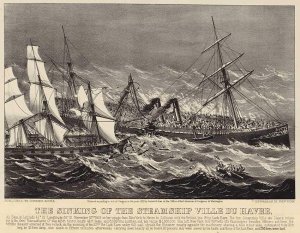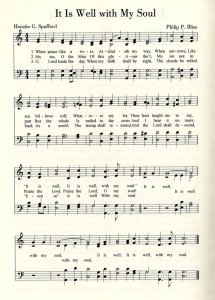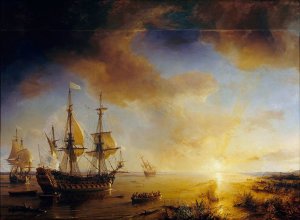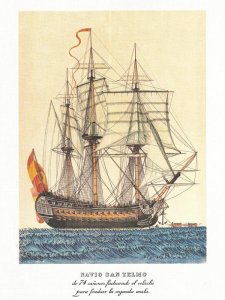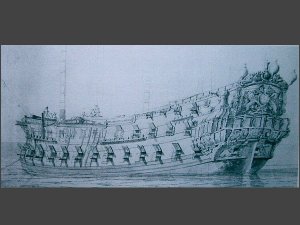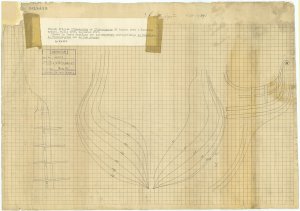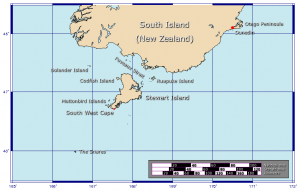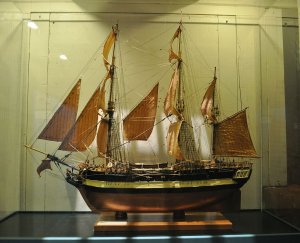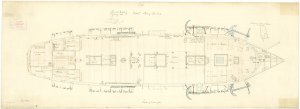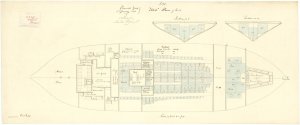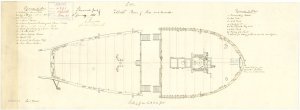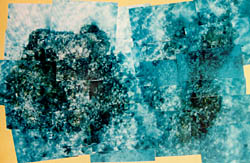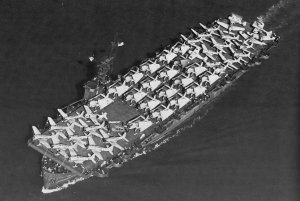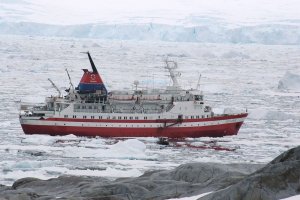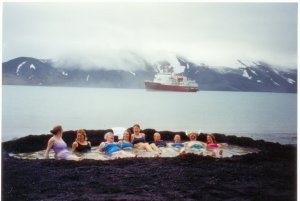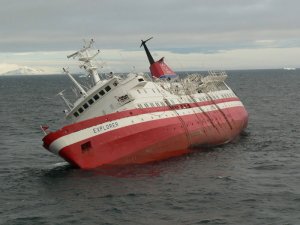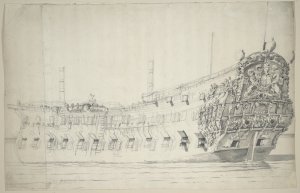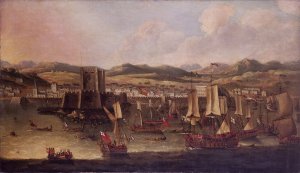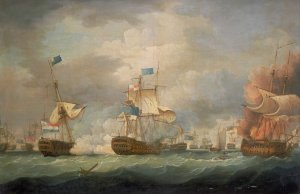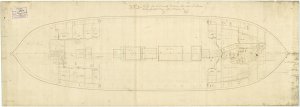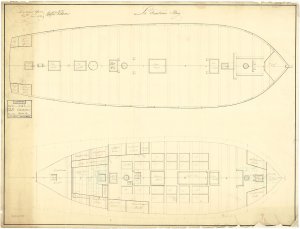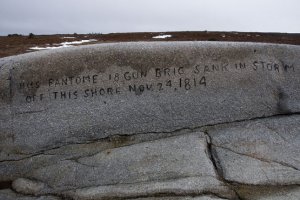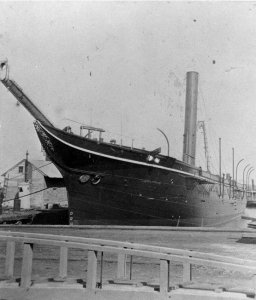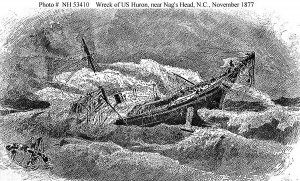Today in Naval History - Naval / Maritime Events in History
22 November 1869 – In Dumbarton, Scotland, the clipper Cutty Sark is launched and is one of the last clippers ever built, and the only one still surviving today.
Cutty Sark is a British clipper ship. Built on the River Clyde in 1869 for the Jock Willis Shipping Line, she was one of the last tea clippers to be built and one of the fastest, coming at the end of a long period of design development, which halted as sailing ships gave way to steam propulsion.
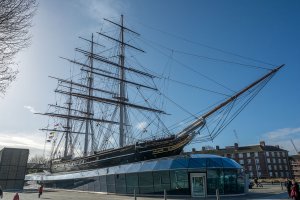
The opening of the Suez Canal (also in 1869) meant that steamships now enjoyed a much shorter route to China, so Cutty Sark spent only a few years on the tea trade before turning to the trade in wool from Australia, where she held the record time to Britain for ten years.[4] Improvements in steam technology meant that gradually steamships also came to dominate the longer sailing route to Australia, and the ship was sold to the Portuguese company Ferreira and Co. in 1895 and renamed Ferreira. She continued as a cargo ship until purchased in 1922 by retired sea captain Wilfred Dowman, who used her as a training ship operating from Falmouth, Cornwall. After his death, Cutty Sark was transferred to the Thames Nautical Training College, Greenhithe in 1938 where she became an auxiliary cadet training ship alongside HMS Worcester. By 1954, she had ceased to be useful as a cadet ship and was transferred to permanent dry dock at Greenwich, London, for public display.
Cutty Sark is listed by National Historic Ships as part of the National Historic Fleet (the nautical equivalent of a Grade 1 Listed Building). She is one of only three remaining original composite construction (wooden hull on an iron frame) clipper ships from the nineteenth century in part or whole, the others being the City of Adelaide, which arrived in Port Adelaide, South Australia on 3 February 2014 for preservation, and the beached skeleton of Ambassador of 1869 near Punta Arenas, Chile.
The ship has been damaged by fire twice in recent years, first on 21 May 2007 while undergoing conservation. She was restored and was reopened to the public on 25 April 2012. On 19 October 2014 she was damaged in a smaller fire.
Construction
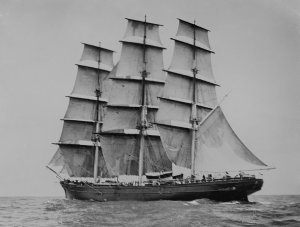
Cutty Sark with sails set. Photograph taken at sea by Captain Woodget with a camera balanced on two of the ship's boats lashed together.
Cutty Sark was ordered by shipping magnate John Willis, who operated a shipping company founded by his father. The company had a fleet of clippers and regularly took part in the tea trade from China to Britain. Speed was a clear advantage to a merchant ship, but it also created prestige for the owners: the 'tea race' was widely reported in contemporary newspapers and had become something of a national sporting event, with money being gambled against a winning ship. In earlier years, Willis had commanded his father's ships at a time when American designed ships were the fastest in the tea trade, and then had owned British designed ships, which were amongst the best available in the world but had never won the tea race. In 1868 the brand new Aberdeen built clipper Thermopylae set a record time of 61 days port to port on her maiden voyage from London to Melbourne and it was this design that Willis set out to better
It is uncertain how the hull shape for Cutty Sark was chosen. Willis chose Hercules Linton to design and build the ship but Willis already possessed another ship, The Tweed, which he considered to have exceptional performance. The Tweed (originally Punjaub) was a frigate designed by Oliver Lang based on the lines of an old French frigate, built in Bombay for the East India Company as a combination sail/paddle steamer. She and a sister ship were purchased by Willis, who promptly sold the second ship plus engines from The Tweed for more than he paid for both. The Tweed was then lengthened and operated as a fast sailing vessel, but was considered too big for the tea runs. Willis also commissioned two all-iron clippers with designs based upon The Tweed, Hallowe'en and Blackadder. Linton was taken to view The Tweed in dry dock.
Willis considered that The Tweed's bow shape was responsible for its notable performance, and this form seems to have been adopted for Cutty Sark. Linton, however, felt that the stern was too barrel shaped and so gave Cutty Sark a squarer stern with less tumblehome. The broader stern increased the buoyancy of the ship's stern, making it lift more in heavy seas so it was less likely that waves would break over the stern, and over the helmsman at the wheel. The square bilge was carried forward through the centre of the ship. In the matter of masts Cutty Sark also followed the design of The Tweed, with similar good rake and with the foremast on both ships being placed further aft than was usual.
A contract for Cutty Sark's construction was signed on 1 February 1869 with the firm of Scott & Linton, which had only been formed in May 1868. Their shipyard was at Dumbarton on the River Leven on a site previously occupied by shipbuilders William Denny & Brothers. The contract required the ship to be completed within six months at a contracted price of £17 per ton and maximum weight of 950 tons. This was a highly competitive price for an experimental, state-of-the-art vessel, and for a customer requiring the highest standards. Payment would be made in seven installments as the ship progressed, but with a penalty of £5 for every day the ship was late. The ship was to be built to Lloyd's A1 standard and her construction was supervised on behalf of Willis by Captain George Moodie, who would command her when completed. Construction delays occurred when the Lloyd's inspectors required additional strengthening in the ship.
Work on the ship was suspended when Scott and Linton ran out of money to pay for further work. Rather than simply liquidate the company, an arrangement was made for Denny's to take over the contract and complete the ship, which was finally launched on 22 November 1869 by Captain Moodie's wife. The ship was moved to Denny's yard to have her masts fitted, and then on 20 December towed downriver to Greenock to have her running rigging installed. In the event, completing the ship meant the company's creditors were owed even more money than when work had first been halted.
Broadly, the parts of the ship visible above the waterline were constructed from East India teak, while American rock elm was used for the ship's bottom. The keel (16.5 in × 15 in (42 cm × 38 cm)) had on either side a garboard strake (11 in × 12 in (28 cm × 30 cm)) and then 6 in (15 cm) planking decreasing to 4.75 in (12.1 cm) at 1/5 the depth of the hold. Teak planking began at approximately the level of the bilge stringer. All the external timbers were secured by Muntz metal (brass) bolts to the internal iron frame and the hull covered by Muntz sheeting up to the 18 ft (5.5 m) depth mark. The stem (15 in × 15 in (38 cm × 38 cm)) and sternpost (16.5 in × 15 in (42 cm × 38 cm)) were of teak while the rudder was of English oak. The keel was replaced in the 1920s with one constructed from 15 in (38 cm) pitch pine. The deck was made of 3.5 in (8.9 cm) thick teak while the 'tween deck was 3 in (7.6 cm) yellow pine. Her length was 212 feet 5 inches (64.74 m) with a draft of 21 feet (6.40 m) and a deadweight of 921 tons.
Performance
The maximum logged speed for Cutty Sark was 17.5 knots (32.4 km/h; 20.1 mph). The speed of a sailing ship is not so straightforward as a steamship, as winds vary and a ship must tack when sailing into the wind, both requiring the crew to make constant adjustments to sails, so her speed also depended greatly on the skill of her captain and crew. Her greatest recorded distance in 24 hours was 363 nautical miles (672 km; 418 mi) averaging 15 knots (28 km/h; 17 mph), although she recorded 2163 miles in six days, which given the weather over the whole period implied she had achieved over 370 nmi (690 km; 430 mi) some days. By comparison, Thermopylae's best recorded 24-hour distance was 358 nmi (663 km; 412 mi). Cutty Sark was considered to have the edge in a heavier wind, and Thermopylae in a lighter wind.
Etymology

The ship's figurehead shows Cutty-sark, the nickname of the witch Nannie Dee who chases Tam o' Shanter, snatching his horse's tail before he escapes by crossing water
The ship was named after Cutty-sark, the nickname of the witch Nannie Dee in Robert Burns's 1791 poem Tam o' Shanter. The ship's figurehead, the original of which has been attributed to carver Fredrick Hellyer of Blackwall, is a stark white carving of a bare-breasted Nannie Dee with long black hair holding a grey horse's tail in her hand. In the poem she wore a linen sark (Scots: a short chemise or undergarment), that she had been given as a child, which explains why it was cutty, or in other words far too short. The erotic sight of her dancing in such a short undergarment caused Tam to cry out "Weel done, Cutty-sark", which subsequently became a well known catchphrase. Originally, carvings by Hellyer of the other scantily clad witches followed behind the figurehead along the bow, but these were removed by Willis in deference to 'good taste'. Tam o' Shanter riding Meg was to be seen along the ship's quarter. The motto, Where there's a Willis away, was inscribed along the taffrail. The Tweed, which acted as a model for much of the ship which followed her, had a figurehead depicting Tam o' Shanter.
Before the fire
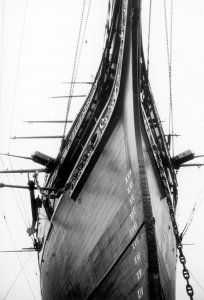

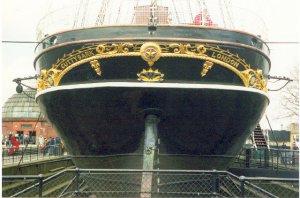

actual status after restoration


https://en.wikipedia.org/wiki/Cutty_Sark
22 November 1869 – In Dumbarton, Scotland, the clipper Cutty Sark is launched and is one of the last clippers ever built, and the only one still surviving today.
Cutty Sark is a British clipper ship. Built on the River Clyde in 1869 for the Jock Willis Shipping Line, she was one of the last tea clippers to be built and one of the fastest, coming at the end of a long period of design development, which halted as sailing ships gave way to steam propulsion.

The opening of the Suez Canal (also in 1869) meant that steamships now enjoyed a much shorter route to China, so Cutty Sark spent only a few years on the tea trade before turning to the trade in wool from Australia, where she held the record time to Britain for ten years.[4] Improvements in steam technology meant that gradually steamships also came to dominate the longer sailing route to Australia, and the ship was sold to the Portuguese company Ferreira and Co. in 1895 and renamed Ferreira. She continued as a cargo ship until purchased in 1922 by retired sea captain Wilfred Dowman, who used her as a training ship operating from Falmouth, Cornwall. After his death, Cutty Sark was transferred to the Thames Nautical Training College, Greenhithe in 1938 where she became an auxiliary cadet training ship alongside HMS Worcester. By 1954, she had ceased to be useful as a cadet ship and was transferred to permanent dry dock at Greenwich, London, for public display.
Cutty Sark is listed by National Historic Ships as part of the National Historic Fleet (the nautical equivalent of a Grade 1 Listed Building). She is one of only three remaining original composite construction (wooden hull on an iron frame) clipper ships from the nineteenth century in part or whole, the others being the City of Adelaide, which arrived in Port Adelaide, South Australia on 3 February 2014 for preservation, and the beached skeleton of Ambassador of 1869 near Punta Arenas, Chile.
The ship has been damaged by fire twice in recent years, first on 21 May 2007 while undergoing conservation. She was restored and was reopened to the public on 25 April 2012. On 19 October 2014 she was damaged in a smaller fire.
Construction

Cutty Sark with sails set. Photograph taken at sea by Captain Woodget with a camera balanced on two of the ship's boats lashed together.
Cutty Sark was ordered by shipping magnate John Willis, who operated a shipping company founded by his father. The company had a fleet of clippers and regularly took part in the tea trade from China to Britain. Speed was a clear advantage to a merchant ship, but it also created prestige for the owners: the 'tea race' was widely reported in contemporary newspapers and had become something of a national sporting event, with money being gambled against a winning ship. In earlier years, Willis had commanded his father's ships at a time when American designed ships were the fastest in the tea trade, and then had owned British designed ships, which were amongst the best available in the world but had never won the tea race. In 1868 the brand new Aberdeen built clipper Thermopylae set a record time of 61 days port to port on her maiden voyage from London to Melbourne and it was this design that Willis set out to better
It is uncertain how the hull shape for Cutty Sark was chosen. Willis chose Hercules Linton to design and build the ship but Willis already possessed another ship, The Tweed, which he considered to have exceptional performance. The Tweed (originally Punjaub) was a frigate designed by Oliver Lang based on the lines of an old French frigate, built in Bombay for the East India Company as a combination sail/paddle steamer. She and a sister ship were purchased by Willis, who promptly sold the second ship plus engines from The Tweed for more than he paid for both. The Tweed was then lengthened and operated as a fast sailing vessel, but was considered too big for the tea runs. Willis also commissioned two all-iron clippers with designs based upon The Tweed, Hallowe'en and Blackadder. Linton was taken to view The Tweed in dry dock.
Willis considered that The Tweed's bow shape was responsible for its notable performance, and this form seems to have been adopted for Cutty Sark. Linton, however, felt that the stern was too barrel shaped and so gave Cutty Sark a squarer stern with less tumblehome. The broader stern increased the buoyancy of the ship's stern, making it lift more in heavy seas so it was less likely that waves would break over the stern, and over the helmsman at the wheel. The square bilge was carried forward through the centre of the ship. In the matter of masts Cutty Sark also followed the design of The Tweed, with similar good rake and with the foremast on both ships being placed further aft than was usual.
A contract for Cutty Sark's construction was signed on 1 February 1869 with the firm of Scott & Linton, which had only been formed in May 1868. Their shipyard was at Dumbarton on the River Leven on a site previously occupied by shipbuilders William Denny & Brothers. The contract required the ship to be completed within six months at a contracted price of £17 per ton and maximum weight of 950 tons. This was a highly competitive price for an experimental, state-of-the-art vessel, and for a customer requiring the highest standards. Payment would be made in seven installments as the ship progressed, but with a penalty of £5 for every day the ship was late. The ship was to be built to Lloyd's A1 standard and her construction was supervised on behalf of Willis by Captain George Moodie, who would command her when completed. Construction delays occurred when the Lloyd's inspectors required additional strengthening in the ship.
Work on the ship was suspended when Scott and Linton ran out of money to pay for further work. Rather than simply liquidate the company, an arrangement was made for Denny's to take over the contract and complete the ship, which was finally launched on 22 November 1869 by Captain Moodie's wife. The ship was moved to Denny's yard to have her masts fitted, and then on 20 December towed downriver to Greenock to have her running rigging installed. In the event, completing the ship meant the company's creditors were owed even more money than when work had first been halted.
Broadly, the parts of the ship visible above the waterline were constructed from East India teak, while American rock elm was used for the ship's bottom. The keel (16.5 in × 15 in (42 cm × 38 cm)) had on either side a garboard strake (11 in × 12 in (28 cm × 30 cm)) and then 6 in (15 cm) planking decreasing to 4.75 in (12.1 cm) at 1/5 the depth of the hold. Teak planking began at approximately the level of the bilge stringer. All the external timbers were secured by Muntz metal (brass) bolts to the internal iron frame and the hull covered by Muntz sheeting up to the 18 ft (5.5 m) depth mark. The stem (15 in × 15 in (38 cm × 38 cm)) and sternpost (16.5 in × 15 in (42 cm × 38 cm)) were of teak while the rudder was of English oak. The keel was replaced in the 1920s with one constructed from 15 in (38 cm) pitch pine. The deck was made of 3.5 in (8.9 cm) thick teak while the 'tween deck was 3 in (7.6 cm) yellow pine. Her length was 212 feet 5 inches (64.74 m) with a draft of 21 feet (6.40 m) and a deadweight of 921 tons.
Performance
A speck on the horizon
One day we sighted a vessel, a mere speck on the horizon, astern of us, and the way she came into view it was evident she was travelling much faster than ourselves. 'Bringing the wind up with her' was remarked on board, and that seemed the only feasible conclusion to arrive at and account for the manner in which she overhauled us. In a few hours she was alongside us, and proved to be the famous British clipper Cutty Sark, one of the fastest ships afloat. She passed us going two feet to our one, and in a short time was hull down ahead of us."
—Wool clipper crewman, 1879
One day we sighted a vessel, a mere speck on the horizon, astern of us, and the way she came into view it was evident she was travelling much faster than ourselves. 'Bringing the wind up with her' was remarked on board, and that seemed the only feasible conclusion to arrive at and account for the manner in which she overhauled us. In a few hours she was alongside us, and proved to be the famous British clipper Cutty Sark, one of the fastest ships afloat. She passed us going two feet to our one, and in a short time was hull down ahead of us."
—Wool clipper crewman, 1879
The maximum logged speed for Cutty Sark was 17.5 knots (32.4 km/h; 20.1 mph). The speed of a sailing ship is not so straightforward as a steamship, as winds vary and a ship must tack when sailing into the wind, both requiring the crew to make constant adjustments to sails, so her speed also depended greatly on the skill of her captain and crew. Her greatest recorded distance in 24 hours was 363 nautical miles (672 km; 418 mi) averaging 15 knots (28 km/h; 17 mph), although she recorded 2163 miles in six days, which given the weather over the whole period implied she had achieved over 370 nmi (690 km; 430 mi) some days. By comparison, Thermopylae's best recorded 24-hour distance was 358 nmi (663 km; 412 mi). Cutty Sark was considered to have the edge in a heavier wind, and Thermopylae in a lighter wind.
Etymology

The ship's figurehead shows Cutty-sark, the nickname of the witch Nannie Dee who chases Tam o' Shanter, snatching his horse's tail before he escapes by crossing water
The ship was named after Cutty-sark, the nickname of the witch Nannie Dee in Robert Burns's 1791 poem Tam o' Shanter. The ship's figurehead, the original of which has been attributed to carver Fredrick Hellyer of Blackwall, is a stark white carving of a bare-breasted Nannie Dee with long black hair holding a grey horse's tail in her hand. In the poem she wore a linen sark (Scots: a short chemise or undergarment), that she had been given as a child, which explains why it was cutty, or in other words far too short. The erotic sight of her dancing in such a short undergarment caused Tam to cry out "Weel done, Cutty-sark", which subsequently became a well known catchphrase. Originally, carvings by Hellyer of the other scantily clad witches followed behind the figurehead along the bow, but these were removed by Willis in deference to 'good taste'. Tam o' Shanter riding Meg was to be seen along the ship's quarter. The motto, Where there's a Willis away, was inscribed along the taffrail. The Tweed, which acted as a model for much of the ship which followed her, had a figurehead depicting Tam o' Shanter.
Before the fire




actual status after restoration


https://en.wikipedia.org/wiki/Cutty_Sark





